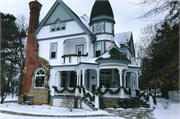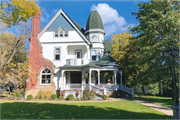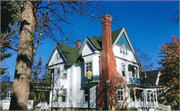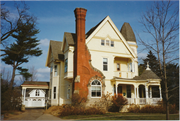| Additional Information: | A 'site file' exists for this property. It contains additional information such as correspondence, newspaper clippings, or historical information. It is a public record and may be viewed in person at the Wisconsin Historical Society, State Historic Preservation Office.
The Winslow House is located on Oakwood Place, the "heart" of the Third Ward Historic District. (See neighboring buildings--the Cutter House, 1302 State Street, 3P/13; the Drummond House, 1310 State Street, 3P/17; and the Galloway House, 213 Oakwood Place, 3P/11.) From Oakwood Place the district stretches east and south to encompass both older and newer structures which blend to form a distinctive area within the city of Eau Claire.
Constructed in 1889, the Winslow House is an excellent example of the Queen Anne style and is among the finest late nineteenth century houses in Eau Claire. The house was designed by George F. Barber, an architect in Knoxville, Tennessee, who ran an extensive pattern book and mail order business from approximately 1888 to 1920. The residence is thus a representative example of the increasingly popular practice of middle class home buyers building an architect-designed house by mail ordering the plans and specifications for a modest fee. The design for the Winslow House originally appeared in the Cottage Souvenir of c. 1888 and was featured in subsequent books by Barber. Other houses from the same design have been located in Jacksonville, Oregon; Calvert, Texas; and Bellevedere and Ottawa, Illinois.
The house, a two-and-a-half story frame dwelling, is distinguished by a massive exterior corner chimney. Resting on a raised stone foundation, the chimney is composed of smooth red brick with terra cotta ornament. A round-arched plate glass window with a delicate fanlight pattern in the arch is set within the brick chimney.
At the opposite corner of the facade is an unusual corner porch which wraps around half of the front and half of the side and which is trimmed by spindle balustrades, curved soffits, miniature Tuscan columns and simple brackets. A round gazebo with a conical roof, an octagonal turret, and a second floor balcony further embellish the southeast corner.
The first floor is clapboard sided while the second story and gables are shingled with decoratively shaped spindles highlighting some surfaces. Projecting from the west side of the house are a two story polygonal bay crowned by a triangular gable supported by plain board brackets; an oriel window with a gable roof and diagonally-boarded surfaces; and a simple porte cochere supported by grouped Tuscan columns. The wall surfaces are broken by vertical and horizontal stickwork. The east side is similar to the west side with one large, gabled wing ending in a two story polygonal bay.
Carrie Winslow was the daughter of Nathaniel Foster, a prominent and successful lumbering and railroad businessman from Fairchild. She married George F. Winslow in 1889. Early in his career, Winslow published the Woodsman Journal. But his major business activity was the manufacture and distribution of "camp remedies" to the lumbermen of northern Wisconsin. These patent medicines included such concoctions as Winslow's Cough Medicine, Magnetic Oil Linament, Blood Purifier, and Magic Bomb. Winslow also owned a drug store which later became a wallpaper and decorating store.
In 1921, Louis G. Arnold and his wife purchased the property. Arnold was a successful civil engineer and road building contractor. In 1975 the Giffens bought the property.
2016- "Carrie Foster, daughter of a prominent lumbering and railroad businessman, married George Winslow in 1889. Mr. Winslow published the Woodsman Journal and manufactured and distributed to the lumbermen of northern Wisconsin patent medicines known as "camp remedies," including magnetic oil liniment, magnetic bomb, and blood purifier. The basic ingredient of all was alcohol.
Middle class Victorians commonly purchased modestly priced mail order house plans designed by architects. This plan was purchased from Tennessee architect George F. Barber. An unusual feature of the house is the distinctive chimney, which frames a window."
-"Eau Claire Landmarks: Designated Historic Properties in Eau Claire, Wisconsin", Eau Claire Landmarks Commission, P.O. Box 5148, 2016.
SEE COUNTY RESOURCE FILE.
Covenant/Easement: From 10/16/1980 to 10/16/1985. A 'covenant file' exists for this property. It may contain additional information such as photos, drawings and correspondence. It is a public record and may be viewed in person at the Wisconsin Historical Society, State Historic Preservation Office. |
|---|





